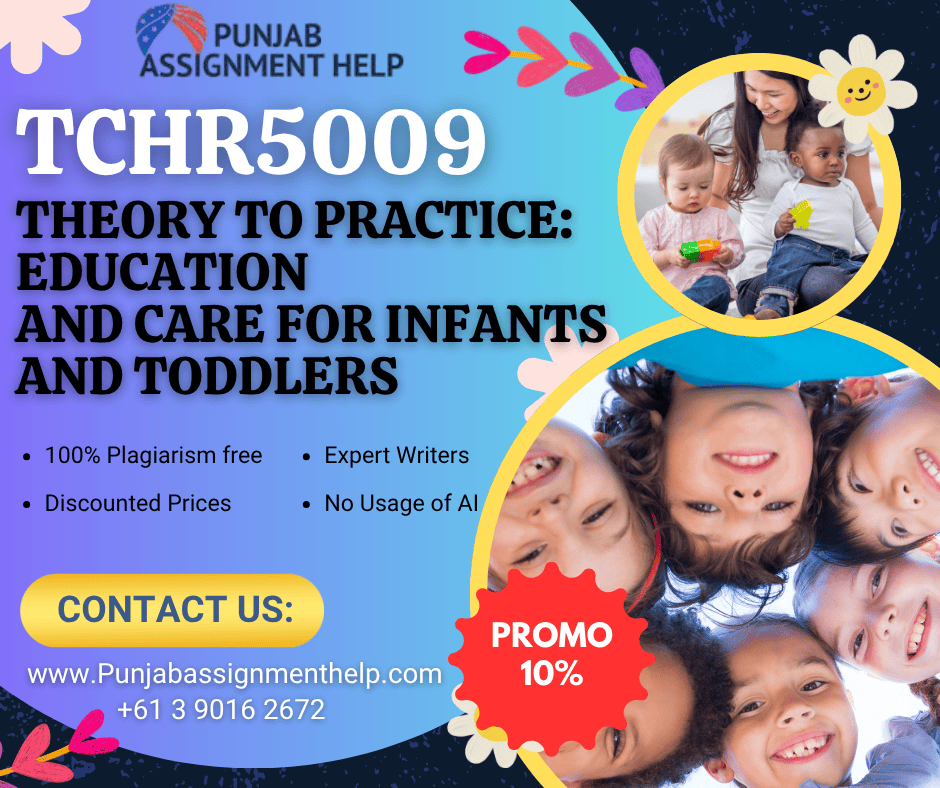
TCHR5009 THEORY TO PRACTICE EDUCATION AND CARE FOR INFANTS AND TODDLERS
Summary
| Title | Assessment Task 1: Professional Philosophy and Critical Reflection |
| Type | Report |
| Due Date | Monday 21st July 2025 @ 11:59 pm AEST (Week 3) |
| Length | 1500 words |
| Weighting | 50% |
| Academic Integrity | In this assessment task, the use of Gen AI is allowed but limited. You may only use Gen AI to help guide you in the process of completing your assessment work. Think of it as a tool. A quick way to access information or an AI tutor to help answer your questions. So, you can use Gen AI to help guide your research, ask questions to help to clarify your understanding, brainstorm preliminary ideas, get feedback on your ideas and clarify concepts. Remember, just as if you Googled something, you still need to evaluate the information to determine its accuracy and relevance. Gen AI can produce biased and false information. You must find scholarly sources to support any of the ideas generated. This is a requirement for this assessment.
You cannot include content generated by AI in your assessment (even if you have paraphrased, summarised or quoted the output). You are only permitted to use Grammarly Premium to help edit and improve the quality of your written work. If you choose to use this, you must provide a draft of your task before it was entered into Grammarly. Attach your draft as an appendix. If you opt to use Gen AI as defined as acceptable for this assessment, you must keep evidence of how it was used and acknowledge how you used it in the process of completing your assessment appropriately. To help understand what to do, consult the Learning Zone’s resources.
If you use Gen AI tools in your assessment task beyond the acceptable limits, it may result in an academic integrity breach against you as described in the Student Academic and Non-Academic Misconduct Rules, Section 3. |
| Submission | Submission of your assessment is via TURN IT IN. The submission link can be found in the Assessment Tasks and Submission Tab in the Black board site. Only Word documents will be accepted.
Please note:
|
 |

|
This task allows students to reflect on theoretical perspectives and practice to develop a professional philosophy for teaching infants and toddlers. By engaging with topics such as attachment, routines, and responsive environments, students will connect research and theory to their beliefs about quality early childhood learning. Through critical reflection, students will explore how their philosophy may be translated to practice, identify potential challenges and propose strategies for overcoming them.
This report is comprised of two tasks and should be presented in ONE Word document. PDF documents will not be accepted.
Write a professional philosophy statement out lining your beliefs, values and approach to working with in fants and toddlers in an early childhood education and care setting.
Your statement should focus on at least three (3) key aspects of infant and toddler learning, development and health and safety such as:
(You may also include other topics that are important to you.)
You must support your philosophy with reference to:
Critically reflect on your professional philosophy and identify three (3) potential challenges you may face when putting it in to practice. For each challenge, you must 1) Explain why it may arise, and 2) Describe how you plan to overcome it, using strategies informed by theory, policy/frameworks and your professional values.
You must support your critical reflection with reference to:
name .E.g: Mills A_assessment 1_report_final copy
Get Plagiarism free Assignment help from Punjab Assignment Help
APA 7th referencing format is required with a minimum of 8 references. The required sources are listed above.
Online Assignment help in Australia
Australian Children’s Education & Care Quality Authority.(2022).The national quality standard.
Assessments should be submitted using the Turn it in link on the Assessments Tasks & Submission section on the Blackboard site. Only Microsoft Word documents submitted via the Turn it in portal on Blackboard will be accepted. Assessment tasks emailed to unit staff will not be accepted. The Word document that is submitted to the final submission link will be marked. You must label your submission with your surname and initials and the assessment task's name.
At Southern Cross University academic integrity means behaving with the values of honesty, fairness, trustworthiness, courage, responsibility, and respect in relation to academic work.
The Southern Cross University Academic Integrity Framework aims to develop a holistic, systematic, and consistent approach to addressing academic integrity across the entire University. For more information,see the SCU Academic Integrity Framework
NOTE: Academic Integrity breaches include poor referencing, not identifying direct quotations correctly, close paraphrasing, plagiarism, recycling, misrepresentation, collusion, cheating, contract cheating, and fabricating information.
Students wishing to request special consideration to extend the due date of an assessment task must submit a Request for Special Consideration form via their My Enrolment page as early as possible and prior to the original due date for that assessment task, along with any accompanying documents, such as medical certificates.
Please refer to the Special Consideration section of Policy https://policies.scu.edu.au/document/view-current.php?id=140
Except when special consideration is awarded, late submission of assessment tasks will automatically lead to the imposition of a penalty. Penalties will be incurred as soon as the deadline is reached.
each subsequent calendar day until the mark reaches zero.” Please refer to the Late Submission & Penalties section of Policy https://policies.scu.edu.au/view.current.php?id=00255
Assessments that have been submitted by the due date will receive an SCU grade. Grades and feedback will be posted to the ‘Grades and Feedback’ section on the Blackboard unit site. Please allow 7-10 days for marks to be posted.
| Assessment 1: Report MARKING RUBRIC | ||||||
| Criteria | High Distinction | Distinction | Credit | Pass | Marginal Fail | Fail |
Task 1: Professional Philosophy (35%) Articulation of professional philosophy for working with infants and toddlers that includes key ideas about learning,development,and health and safety. | Professional philosophy is exceptionally clear, insightful and personalised, and clearly demonstrates beliefs and values related to working with infants and toddlers. It shows a deep understanding of infant and toddlers learning,development,and health and safety. | Professional philosophy is well- developed and clearly written and demonstrates beliefs and values related to working with infants and toddlers. It demonstrates a strong understanding of infant and toddler learning,development,and health and safety. | Professional philosophy is clearly expressed and includes relevant content about infant and toddler learning,development, and health and safety. Some aspects of the philosophy may be under developed or too general. | Professional philosophy is adequately written but is general or descriptive. Includes some relevant content about infant and toddler learning,developing, and health and safety but lacks depth or clarity. | Professional philosophy is unclear, or overly vague. It shows little understanding of infant and toddler learning,development, or health and safety. | Professional philosophy is unclear,in appropriate or vague.It shows no understanding of infant and toddler learning,development, or health and safety. |
Task 2: Critical reflection (35%) Critical reflection on philosophy and implementation challenges, with informed strategies. | Provides a highly insightful, well-structured, and critically reflective response. Each challenge is clearly identified and deeply analysed, showing sophisticated understanding of infant and toddler practice. Strategies to over come challenges are highly relevant and clearly justified. The reflection shows strong alignment between philosophy and practice. | Provides a thoughtful and well- organised reflection. Each challenge is clearly identified.Strategies are relevant and justified. The reflection shows a strong link between philosophy and practice. | Provides a clear and generally well-structured reflection.Challenges are identified and explained with some depth,and strategies are mostly appropriate. Reflection may be more descriptive than analytical but still shows a good understanding of the philosophy-to-practice link. | Provides a basic reflection with limited critical analysis.Challenges may be superficially explained or generalised. Strategies are included but may be vague,underdeveloped or lack justification. Limited link between philosophy and practice. | Reflection is poorly structured or lacks clarity. Challenges are underdeveloped, incomplete, or only partly relevant. Strategies are unclear or minimally justified. Demonstrates minimal critical thinking and lacks clarity in linking philosophy to practice. | Reflection is unclear, disorganised or missing key elements. Challenges are not identified or are irrelevant.Strategies are absent,inappropriate or unjustified.No understanding of how philosophy relates to practice. |
| Use of set text, the EYLFV2.0, NQS, academic literature (20%) | Demonstrates outstanding integration of the set text, EYLFV 2.0, NQS, and a wide range of high-quality, current and relevant academic literature.Sources are seamlessly embedded to strengthen both the professional philosophy and critical reflection. | Demonstrates strong use of the set text, EYLF V2.0, NQS, and relevant academic literature.Some integration may lack depth or clarity,but overall, the use of sources enhances the professional philosophy and critical reflection. | Demonstrates adequate use of set text, EYLF V2.0, NQS and relevant academic literature.Support for ideas is generally relevant but may be descriptive or in consistently applied. There may be limited evidence of wider reading. | Demonstrates basic use of the set text, EYLF V2.0, NQS and academic literature but maybe limited in relevance or depth. | Limited use of set text,the EYLF V2.0,NQS. Integration of literature is minimal or in appropriate. | No or minimal use of the required set text,EYLF, NQS,or academic literature. |
Academic Literacy (10%) | Displayed outstanding Academic Literacy, including all of the following: Correct word count(+/- 10%), correct writing conventions,correctly formatted APA 7th in-text citations and reference list. | Displayed comprehensive Academic Literacy, including all or most of the following:Correct word count (+/- 10%),correct writing conventions,correctly formatted APA 7th in-text citations and reference list. | Displayed solid Academic Literacy, including some or most of the following: Correct word count (+/- 10%), correct writing conventions,correctly formatted APA 7th in-text citations reference list. | Displayed satisfactory Academic Literacy, including some of the following: Correct word count(+/- 10%), correct writing conventions,correctly formatted APA 7th in-text citations and reference list. | Limited Academic Literacy.Mostly incorrect word count,writing conventions and APA 7th in-text citations and reference list. | Failed to display satisfactory Academic Literacy. Incorrect word count,incorrect writing conventions, incorrectly formatted APA 7th in-text citations and reference list. |

 |
 |

Description of SCU Grades
The student’s performance, in addition to satisfying all of the basic learning requirements, demonstrates distinctive insight and ability in researching, analysing and applying relevant skills and concepts, and shows exceptional ability to synthesise, integrate and evaluate knowledge. The student’s performance could be described as outstanding in relation to the learning requirements specified.
The student’s performance, in addition to satisfying all of the basic learning requirements, demonstrates distinctive insight and ability in researching, analysing and applying relevant skills and concepts, and shows a well-developed ability to synthesise, integrate and evaluate knowledge. The student’s performance could be described as distinguished in relation to the learning requirements specified.
The student’s performance, in addition to satisfying all of the basic learning requirements specified, demonstrates insight and ability in researching, analysing and applying relevant skills and concepts. The student’s performance could be described as competent in relation to the learning requirements specified.
The student’s performance satisfies all of the basic learning requirements specified and provides a sound basis for proceeding to higher-level studies in the subject area. The student’s performance could be described as satisfactory in relation to the learning requirements specified.
The student’s performance fails to satisfy the learning requirements specified


Get original papers written according to your instructions and save time for what matters most.